
TNU Journal of Science and Technology
230(01): 200 - 208
http://jst.tnu.edu.vn 200 Email: jst@tnu.edu.vn
EFFECT OF PECTINASE ENZYME ON EXTRACTION EFFICIENCY AND
BIOACTIVE COMPOUNDS OF BLACK MULBERRY JUICE (MORUS NIGRA L.)
WITH ULTRASOUND-ASSISTED
Phuc-Nguyen Dinh, Nhu-Ngoc Nguyen*
Nguyen Tat Thanh University
ARTICLE INFO
ABSTRACT
Received:
12/8/2024
Black mulberry is widely used in Vietnam because of its flavor and high
nutritional value. This study aimed to examine the impact of pectinase
enzyme concentration on the extraction recovery efficiency, total
polyphenol content (TPC), anthocyanin content (ACN), antioxidant
activity (DPPH), and turbidity of black mulberry juice. To process and
extract the juice, different concentrations of pectinase (0%, 0.05%, 0.1%,
0.2%, and 0.4%) were used, along with 30kHz ultrasound-assisted
conditions. The pectinase enzyme used in this study was obtained by
fermenting Aspergillus niger with supplemented pectin from red dragon
fruits. The results showed that treatment with pectinase enzyme at
different concentrations affected the recovery efficiency, TPC, DPPH,
ACN, and turbidity. The recovery efficiency reached high values of
88.04% and 88.23% at 0.2 and 0.4% enzyme concentrations,
respectively. Similarly, the turbidity of black mulberry juice was also
best obtained at enzyme concentrations of 0.2 and 0.4%. However, TPC,
ACN and DPPH gave the best results when treated with the enzyme at a
concentration of 0.2%.
Revised:
17/10/2024
Published:
18/10/2024
KEYWORDS
Morus nigra
Pectinase
Ultrasound
Anthocyanin
Polyphenol
TÁC ĐỘNG CỦA ENZYME PECTINASE ĐẾN HIỆU SUẤT THU HỒI VÀ
HOẠT TÍNH SINH HỌC CỦA NƯỚC DÂU TẰM ĐEN (MORUS NIGRA L.)
CÓ SỰ HỖ TRỢ CỦA SÓNG SIÊU ÂM
Nguyễn Đình Phúc, Nguyễn Như Ngọc*
Trường Đại học Nguyễn Tất Thành
THÔNG TIN BÀI BÁO
TÓM TẮT
Ngày nhận bài:
12/8/2024
Dâu tằm đen được sử dụng rộng rãi ở Việt Nam bởi vì hương vị và giá
trị dinh dưỡng cao. Trong nghiên cứu này, enzyme pectinase sử dụng
cho quá trình thu nhận dịch dâu tằm đen là enzyme thu được từ quá trình
lên men nấm mốc Aspergillus niger trên môi trường có bổ sung pectin
thanh long đỏ. Nồng độ enzyme pectinase khảo sát lần lượt là 0; 0,05;
0,1; 0,2 và 0,4% cùng với sự hỗ trợ của sóng siêu âm 30kHz. Dịch chiết
dâu tằm đen được thu nhận và đánh giá ảnh hưởng của nồng độ enzyme
pectinase đến hiệu suất thu hồi dịch chiết, hàm lượng polyphenol (TPC),
hàm lượng anthocyanin (ACN), hoạt tính chống oxy hóa (DPPH), và độ
đục của dịch dâu tằm đen. Kết quả cho thấy xử lý enzyme pectinase ở
các nồng độ khác nhau ảnh hưởng đến hiệu suất thu hồi, hàm lượng
TPC, DPPH, anthocyanin và độ đục. Hiệu suất thu hồi đạt các giá trị
cao lần lượt là 88,04% và 88,23% ở nồng độ enzyme 0,2 và 0,4%.
Tương tự như vậy, độ đục của dịch dâu tằm đen cũng đạt tốt nhất ở nồng
độ enzyme 0,2 và 0,4%. Tuy nhiên, khả năng loại bỏ tổng hợp phenolic,
anthocyanin và gốc tự do DPPH mang lại kết quả tốt nhất khi được xử
lý bằng enzyme ở nồng độ 0,2%.
Ngày hoàn thiện:
17/10/2024
Ngày đăng:
18/10/2024
TỪ KHÓA
Dâu tằm đen
Enzyme pectinase
Sóng siêu âm
Anthocyanin
Polyphenol
DOI: https://doi.org/10.34238/tnu-jst.10921
* Corresponding author. Email: nnngoc@ntt.edu.vn





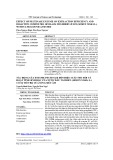



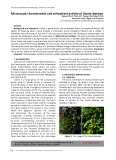
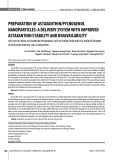
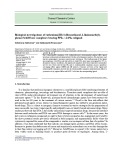
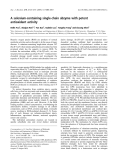

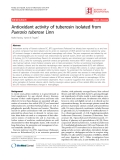
![Báo cáo y học: "Behavioral and antioxidant activity of a tosylbenz[g]indolamine derivative. A proposed better profile for a potential antipsychotic agent"](https://cdn-beta.tailieu.vn/images/document/thumbnail/2011/20111009/thulanh10/135x160/1475_2832_3_1_0587.jpg)
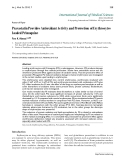
![Báo cáo vật lý: "Evaluation of In Vitro Antioxidant Activity of 5H-dibenz[b,f]azepine and Its Analogues"](https://cdn-beta.tailieu.vn/images/document/thumbnail/2011/20110915/hoami_266/135x160/16753402_21_1_7_3577.jpg)















